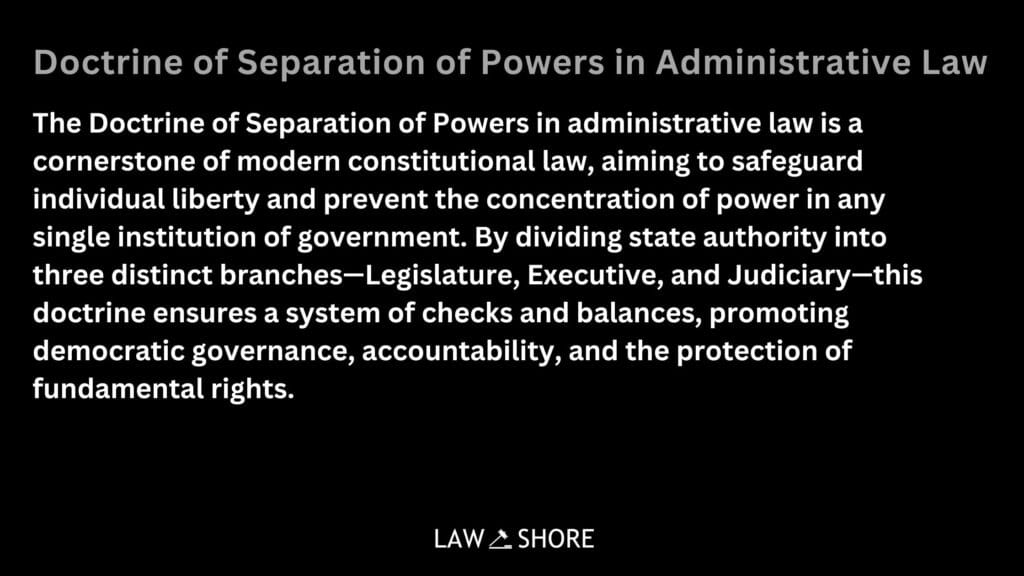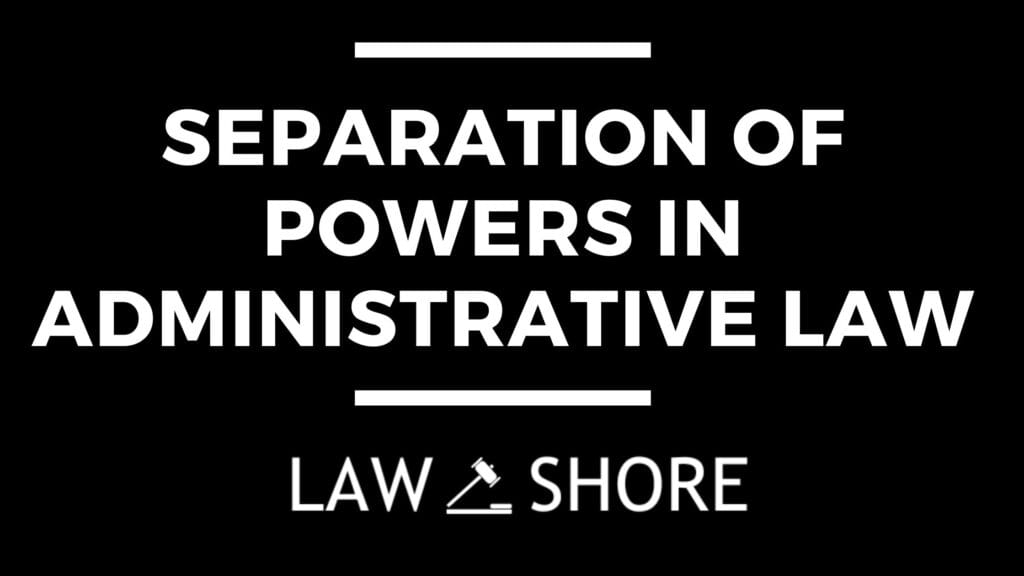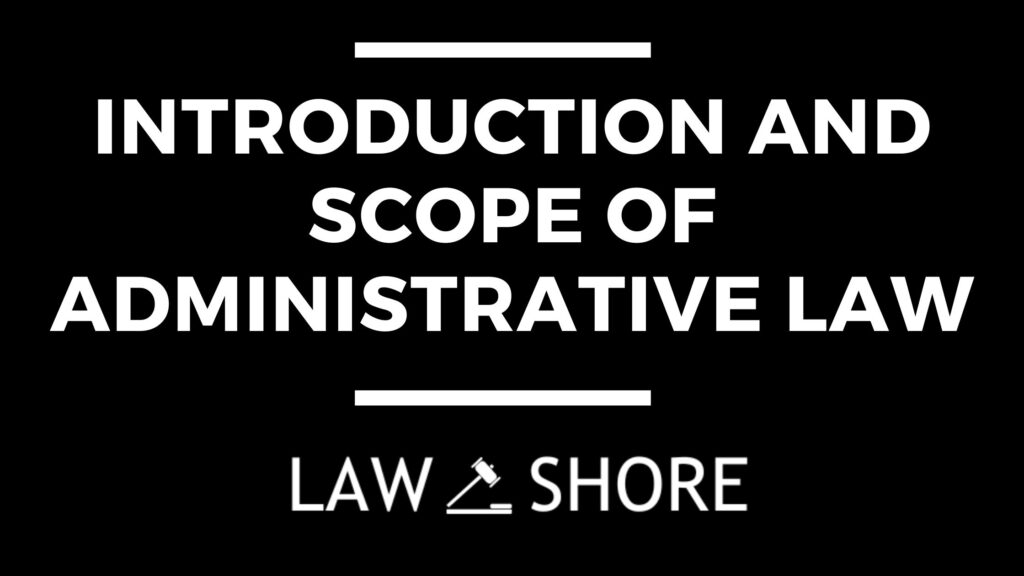Doctrine of Separation of Powers in Administrative Law
Table of Contents
ToggleThe Doctrine of Separation of Powers in Administrative Law is a cornerstone of modern constitutional law, aiming to safeguard individual liberty and prevent the concentration of power in any single institution of government. By dividing state authority into three distinct branches—Legislature, Executive, and Judiciary—this doctrine ensures a system of checks and balances, promoting democratic governance, accountability, and the protection of fundamental rights.

Origins and Concept of the Doctrine
The concept of separation of powers in Administrative Law was famously articulated by the French philosopher Montesquieu in his seminal work The Spirit of the Laws (1748). He argued that the best way to prevent tyranny and safeguard liberty was to divide governmental powers into three separate and independent branches:
- The Legislature should not exercise executive or judicial powers.
- The Executive should not exercise legislative or judicial powers.
- The Judiciary should not exercise executive or legislative powers.
For Montesquieu, the preservation of individual freedom and the avoidance of autocracy depended on ensuring that no single body or individual wielded all three powers. This theory has influenced democratic governance worldwide, especially in parliamentary systems.
Objective of the Doctrine
The primary objective of the Doctrine of Separation of Powers is to prevent any one branch from becoming too powerful. While its aim is to limit usurpation and the potential for autocratic rule, it also ensures that each branch acts within its legal scope and does not misuse its powers. In practical terms, the doctrine operates as a system of “checks and balances,” where the powers of one branch are countered and regulated by the others. Its importance lies not only in its philosophical justification but also as a functional necessity to prevent the abuse of power.
Separation of Powers in the Indian Context
Although the Indian Constitution does not explicitly mention the Doctrine of Separation of Powers in the way it is articulated in the U.S. Constitution, it implicitly supports this principle. The Constitution establishes distinct roles for each branch of government, yet recognizes that these branches can overlap in certain areas. This model, unique to India, ensures that while each branch retains autonomy, they function in a coordinated and interdependent manner, promoting accountability and balance.
1. The Legislature
The Indian Legislature consists of two houses: the Lok Sabha (House of the People) and the Rajya Sabha (Council of States). The Legislature holds the primary authority to make laws, scrutinize the Executive, and represent the interests of the people. Parliament’s ability to check the Executive includes tools like debates, questions, and no-confidence motions.
2. The Executive
The Executive in India is headed by the President, supported by the Prime Minister and the Council of Ministers, as well as the civil services. The Executive’s primary responsibility is the implementation of laws passed by the Legislature. In India’s parliamentary system, the Executive is drawn from the Legislature, and the President must act according to the advice of the Council of Ministers.
Key Constitutional Provisions:
- Article 53: Vests executive power in the President of India.
- Article 74: Specifies that the President must act according to the advice of the Council of Ministers.
- Article 77: Provides for the conduct of business by the Government of India.
3. The Judiciary
The Judiciary in India is tasked with interpreting the Constitution and laws, resolving disputes, and ensuring that government actions conform to legal norms. The Judiciary holds significant power of judicial review, enabling it to invalidate laws or executive orders that contradict the Constitution.
Key Constitutional Provisions:
- Article 124: Establishes the Supreme Court of India.
- Article 226: Empowers High Courts to issue writs for the enforcement of fundamental rights.
- Article 50: Directs the state to take steps for the separation of the judiciary from the executive in public services.
Does the Constitution of India Permit Separation of Powers?
While the Indian Constitution does not explicitly enshrine the doctrine in the same manner as in some other countries, it fundamentally supports it through the establishment of three distinct branches, each with its own functions and powers. However, the separation in India is functional, not absolute, allowing for certain overlaps and interactions between the branches. This functional approach ensures coordination and accountability without compromising the principle of separation.
1. Functional Separation, Not Rigid Separation
Unlike the U.S. model, where the separation is absolute, India’s system allows for a flexible, functional separation of powers. For example:
The Executive (Prime Minister and Council of Ministers) is drawn from the Legislature, indicating a fusion of powers.
The President holds executive powers but exercises them based on the advice of the Council of Ministers, a legislative body.
2. Judicial Review as a Check on the Executive and Legislature
One of the most significant features of the Indian model of separation is the judicial review mechanism. The Judiciary has the authority to scrutinize laws and executive actions, ensuring they conform to the Constitution. This check is vital for preventing the abuse of power by the other branches.
3. Judicial Independence
A robust system of judicial independence is crucial for maintaining the balance between the branches of government. The Constitution provides safeguards to ensure the Judiciary can review actions of the Executive and Legislature without political interference
Significant Articles Related to Judicial Independence:
- Article 124(2): Specifies the procedure for the appointment and removal of Supreme Court judges.
- Article 50: Directs the state to take steps to separate the judiciary from the executive in public services.
Relevance of Separation of Powers in Modern India
In contemporary India, the relevance of the separation of powers in Administrative Law remains significant, even though the system is not characterized by a rigid separation. The principle continues to serve several key functions:
- Modern Governance and Overlap of Powers India’s parliamentary system inherently involves overlapping powers between the Executive and Legislature, which complicates the strict application of separation. However, this overlap is counterbalanced by:
– The Judiciary’s role in ensuring constitutional adherence.
– The Executive’s accountability to the Legislature, particularly through mechanisms like no-confidence motions. - Accountability and Protection of Rights The Judiciary plays a critical role in holding the Executive and Legislature accountable by ensuring that their actions comply with constitutional provisions, particularly regarding fundamental rights.
- Judicial Oversight Landmark judicial decisions have reinforced the importance of separation of powers. In cases like Kesavananda Bharati (1973) and Minerva Mills (1980), the Supreme Court emphasized that judicial review and the separation of powers are essential elements of India’s constitutional framework.
Challenges in Applying Strict Separation of Powers in Administrative Law
Despite its theoretical importance, several challenges arise in applying the doctrine of separation of powers in Administrative Law in India:
Executive-Legislature Fusion
The fusion of powers in India’s parliamentary system, where the Prime Minister and Council of Ministers are drawn from the Legislature, complicates the application of strict separation. This fusion can potentially lead to the Executive wielding significant influence over the Legislature, making it harder for the latter to act as an effective check on the former.
Judicial Overreach
There have been instances of judicial overreach, where the Judiciary has been accused of encroaching on the domain of the Executive and Legislature. For example, the Supreme Court’s role in judicial appointments and interventions in legislative matters through Public Interest Litigations (PILs) has sparked debates about the scope of judicial powers.
Administrative Overreach and Executive Supremacy
The expansive discretionary powers exercised by the Executive, especially through ordinances and executive orders, can blur the lines between the branches, leading to concerns about the potential for executive overreach.
Landmark Judicial Decisions
- Kesavananda Bharati v. State of Kerala (1973): This landmark case reinforced the Basic Structure Doctrine, affirming that the separation of powers is an inviolable part of the Constitution’s structure.
- Minerva Mills Ltd. v. Union of India (1980): The Court emphasized that judicial review and the doctrine of separation of powers are integral to the Constitution.
- S. R. Bommai v. Union of India (1994): The Court upheld the independence of the judiciary and the separation of powers, particularly regarding the President’s powers under Article 356.
- Supreme Court Advocates-on-Record Association v. Union of India (2016): This ruling validated the Collegium system for judicial appointments, reinforcing judicial independence.
Criticism of the Doctrine
- Overlap of Powers The fusion of powers in India’s parliamentary system often results in executive dominance over the Legislature, weakening the Legislature’s role as a check on the Executive.
- Judicial Overreach Critics argue that the Judiciary’s active role in reviewing laws and executive actions sometimes undermines the democratic principle of legislative supremacy.
- Inefficiency and Gridlock A rigid separation of powers can lead to inefficiency, especially in systems where the Executive and Legislature are completely separate. In India, the overlap between the Executive and Legislature allows for more expedient decision-making.
- Political and Administrative Realities The political realities in India, such as party discipline in the Legislature and executive dominance, often challenge the ideal of separation of powers.
Conclusion
While the Indian Constitution does not explicitly outline the doctrine of separation of powers in Administrative Law, it remains a fundamental principle embedded within India’s constitutional framework. The distinct roles of the Legislature, Executive, and Judiciary, and the mechanisms of checks and balances, ensure that no branch can operate unchecked. Though the system is not characterized by an absolute separation, it is crucial for maintaining democracy, protecting rights, and ensuring accountability in governance. The judiciary, particularly through its power of judicial review, plays a vital role in upholding the separation of powers in Administrative Law, ensuring that each branch remains within its constitutional limits.
Also, Check Out Other Topics in Administrative Law:
- Introduction and Scope of Administrative Law
- Droit Administratif
- Ombudsman in Administrative Law
- Promissory Estoppel in Administrative Law
- Public Corporation in Administrative Law
- Reasons for Growth of Administrative Law
- Doctrine of Ultra Vires in Administrative Law
- Whistleblowing
- Nature of Administrative Law
- Red Light and Green Light Theory of Administrative Law
- Sub Delegation in Administrative Law
- Delegatus Non Potest Delegare
Explore Law Shore: law notes today and take the first step toward mastering the fundamentals of law with ease.

After Completing my LLB hons, I started writing content about legal concepts and case laws while practicing. I finally started Law Shore in 2024 with an aim to help other students and lawyers.



